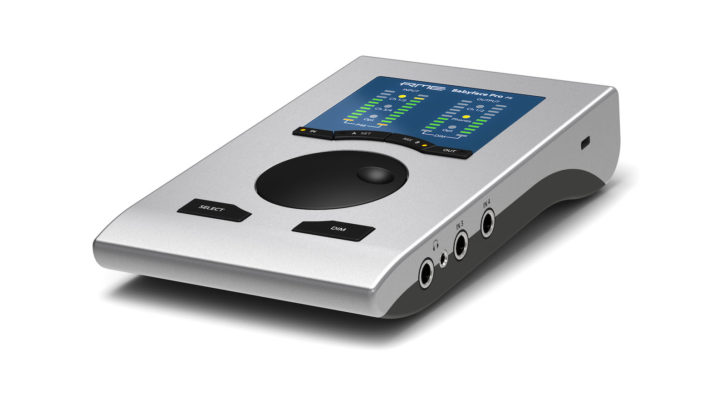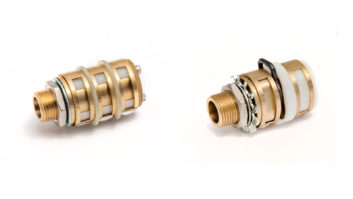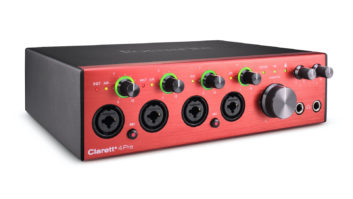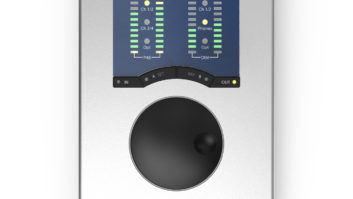
RME Audio introduced its popular Babyface series of audio interfaces back in 2010, then updated it in 2015 with the Babyface Pro. The latest version—Babyface Pro FS—boasts several significant changes, among which are the use of RME’s proprietary SteadyClock FS circuitry originally developed for the company’s high-end ADI-2 Pro FS interface. SteadyClock FS has extremely high resolution that reportedly reduces jitter to levels so low that they are measured in FemtoSeconds (a FemtoSecond is one-quadrillionth of a second!).
Additional improvements include an increase in the signal-to-noise ratio of the microphone preamps and instrument/line inputs (from 112.2 to 113.7 dB, and 114 to 116.3 dB, respectively) and an 8 dB reduction in THD.
Babyface Pro FS headphone outputs employ the same amplification circuitry used in the ADI-2-Pro, increasing maximum power from 70 mW to 90 mW, while reducing impedance of the 3.5mm output from 2 to 0.1 Ohm. A switch recessed into the bottom panel toggles output level between +19 and +4dBu, acting as sort of an output pad for maintaining a high signal-to-noise ratio when the unit is connected to active monitors with high input sensitivity.
INS AND OUTS
Babyface Pro FS is a 12×12 interface. Analog I/O includes two balanced XLR, digitally controlled microphone preamps with phantom power, two ¼-inch TS analog instrument/line level inputs, and balanced line-level XLR outs. Outputs 3 and 4 feed two headphone jacks and can route a mix independent from the control room mix. The ¼-inch headphone output is optimized for highimpedance phones, while the 3.5mm output is optimized for low-impedance cans.
Digital I/O is via optical connection and can handle eight channels of ADAT I/O at 44.1 or 48 kHz/24-bit, or four channels at 96 kHz/24-bit (S/MUX II). These ports can also be used to route S/PDIF, with the optical input automatically detecting presence of ADAT or S/PDIF. The Babyface Pro FS operates at sample rates ranging from 44.1 to 192 kHz; clock may be sourced internally or via the digital input.
The remaining ports on the Babyface Pro FS include a power supply jack for an optional 12VDC power supply, USB 2.0 connection, and a mini DIN connector for use with a MIDI I/O breakout cable (included). The unit can be bus-powered, in which case RME recommends against the use of USB extension cables or hubs.
NAVIGATION CONTROL
The control panel of Babyface Pro FS is sleek and elegant, providing an array of six pushbuttons, a rotary encoder and a multifunction LED display.
Four LED bands indicate preamp gain settings, phantom power status, input and output levels, clipping, or which channel has been selected for adjustment. The In and Select keys are used to access inputs. Pressing In toggles between inputs A1/2, A3/4 and optical 1/2. Pressing Select shifts control from the first to the second input of the pair or to both for adjustment of a stereo input (very clever). Similarly, pressing the Out button toggles through Main XLR, Phones or the first two channels of the optical outputs, and the encoder sets output level. When an input channel has been selected, the rotary encoder is used to adjust gain.
Brainworx bx_console AMEK 9099 – A Real-World Review
Analysis Plus Pro Audio QiJack – A Real-World Review
Vanguard Audio V44S Gen2 Microphone – A Real-World Review
As you’d expect, the Dim button reduces output level for the main audio outputs, but it can be reprogrammed for switching to a second set of speakers or for engaging talkback. Two hotkeys labeled A (Set) and B (Mix) can also be programmed to execute a variety of functions, including talkback, speaker B select, volume recall and more. The default for A is recall of a user-defined listening level, and the default for B is control of the direct monitoring system whereby an input is routed directly to an output for zero-latency monitoring.
The Babyface Pro FS can be operated in three different modes: driver-based USB2, class-compliant mode (mainly for use with an iPad), and as a standalone mixer. Using the interface in either of the latter two modes requires use of an external power supply.
A DSP-based mixer called Totalmix allows fully independent routing and mixing of input and playback channels to all physical outputs. Totalmix allows you to create up to six independent, zero-latency stereo submixes with reverb and delay, and provides a control room section with advanced functions such as mono summing, talkback, dim and FX mute.
The unit also ships with a plug-in bundle that includes Brainworx bx_Opto, Brainworx bx_Masterdesk, Scuffham Amps’ S-Gear, and trial versions of Gig Performer, Pianoteq 6 by Modartt, and Blue 3 Organ by GG Audio.
OUT OF THE BOX…
The first thing I noticed when unpacking Babyface Pro FS is its heft—it’s heavy for its size and beautifully constructed. The controls have a solid feel, particularly the encoder, which responds smoothly and without play.
The packaging includes a cloth bag for the interface, a MIDI breakout cable, USB Type A and C cables, a printed manual and a hard plastic storage case to hold everything.
…INTO THE STUDIO
I used Babyface Pro FS with a variety of DAW software, including Pro Tools, Digital Performer and Reason, and it played well with all of them. The front panel UI looks great, but the sparse number of controls also means a fair amount of button pushing to navigate.
I found it far easier to control the device through Totalmix, where the Channel view displays settings for fader level, meter, pan, mute, solo and effect send. Clicking on the tool icon expands the Channel view to show stereo or mono mode, 48V phantom power status, pad, gain, stereo width (for stereo pairs), FX send level, Mid-Side processing and phase. Given the fact that Babyface Pro FS has only four analog inputs, I generally opted to leave the expanded view open.
Totalmix operates in two different modes: Full Mode (the mixer is active and all routing options are available), and Digital Audio Workstation Mode (which provides straight playback routing; you use your DAW to mix inputs).
Using Full Mode, it was easy to create latency-free monitoring for tracking and overdubbing. I found that once I had Totalmix set up and saved, I generally used the software to manage most of the settings with the exception of control room volume—which was easily controlled using the rotary encoder on the unit itself.
The mic preamps in Babyface Pro FS are serious, and they hold their own against expensive outboard preamps. I liked the fact that the phantom power produces true 48VDC, a trait that a lot of desktop interfaces lack. Recording vocals with a Neumann U87 into the Babyface Pro FS yielded very low noise, detail and transparency, sounding as good as you’d expect a U87 to sound.
I also used Babyface Pro FS in conjunction with my Metric Halo Labs LIO8 to multitrack a drum kit. Kick and snare mics were connected to the unit’s preamps, and the remainder of the preamps were patched to the LIO8. The LIO8 ADAT output was connected to the optical input on the Babyface Pro FS, allowing me to expand the interface’s input capabilities.
The snare sound was crisp and smooth with excellent impact, while the bottom end of the kick was extended and tight. Babyface Pro FS had no problems locking to clock via the ADAT signal, and it’s great to know that there exists a painless possibility for expansion in the event that you need more inputs. Babyface FS Pro ADAT outputs can be used to route multiple headphone mixes if you’re willing to add external hardware to convert ADAT to analog. It’s probably more than most users will ever need, but it’s there if you need it.
Inputs 3 and 4 can be independently switched (in Totalmix) between +4 dBu or -10 dBV, which enabled me to use them as line inputs or DIs for recording electric guitar, bass and synths. Bass through the DI was extended but controlled, and—using the included Scuffham Amps’ S-Gear amp simulator—I was able to create some seriously good electric guitar tones.
SERIOUS GEAR
There are a lot of audio interfaces in desktop packages with similar I/O capabilities as Babyface Pro FS, but any similarities end there. This is a premium interface with preamps and converters of the highest quality, easily capable of competing with interfaces at higher price points—and most of the competition lacks the routing capabilities of Babyface Pro FS.
If your recording needs don’t require a high analog channel count but demand excellent audio quality, listen to the Babyface Pro FS. You will not be disappointed.
PRODUCT SUMMARY COMPANY: RME Audio
PRODUCT: Babyface Pro FS Interface
WEBSITE: www.rme-usa.com
PRICE: $1,099 MSRP
PROS: Sounds great; elegant construction; ability to record audio files with EQ; excellent headphone amps.
CONS: Minimal controls on front panel; some functions may be accessed only through Totalmix software.







